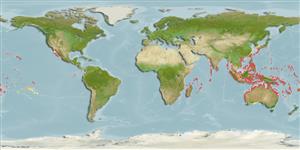Environment: milieu / climate zone / depth range / distribution range
Écologie
marin récifal; profondeur 8 - 20 m (Ref. 9710). Tropical; 35°N - 35°S
Indo-Pacific: East Africa to Samoa, north to southern Japan, south to New South Wales and Tonga.
Taille / Poids / Âge
Maturity: Lm ? range ? - ? cm
Max length : 13.0 cm SL mâle / non sexé; (Ref. 48637)
Épines dorsales (Total): 1 - 2; Rayons mous dorsaux (Total): 29-34; Épines anales 0; Rayons mous anaux: 26 - 30. Body and head color variable. Blackish to dark bluish branchial blotch extending dorsally to level well above the lower margin of eye and may include ventrally the pectoral fin base and axil. Iris usually dark brown. Orange to red caudal fin soft dorsal and anal fins clear, orange or yellow with spots; pectorals clear. Scale spinulation at midbody closely packed. Male scale ridge rugosities develop at about 80 mm SL developed. Strong first dorsal spine. Large pelvic fin rudiment narrowly attached to posterior margin of ventral flap.
Occurs in shallow lagoons and seaward reefs to a depth of about 15 m; common in coral-rich areas. Secretive species (Ref. 9710, 48637) among rocks, sponges or in crevices on the bases of large coral formations. Adults usually form pairs but often only one is observed while the other one is hiding (Ref. 48637).
Life cycle and mating behavior
Maturité | Reproduction | Frai | Œufs | Fécondité | Larves
Hutchins, J.B., 1986. Review of the monacanthid fish genus Pervagor, with descriptions of two new species. Indo-Pac. Fish. (12):35 p. (Ref. 527)
Statut dans la liste rouge de l'IUCN (Ref. 130435)
Menace pour l'homme
Harmless
Utilisations par l'homme
Plus d'informations
Noms communsSynonymesMétabolismePrédateursÉcotoxicologieReproductionMaturitéFraiRassemblement de ponteFéconditéŒufsDéveloppement de l'œuf
RéférencesAquacultureProfil d'aquacultureSouchesGénétiqueElectrophoresesHéritabilitéPathologiesTraitementNutrientsMass conversion
CollaborateursImagesStamps, Coins Misc.SonsCiguateraVitesseType de nageSurface branchialeOtolithesCerveauxVision
Outils
Articles particuliers
Télécharger en XML
Sources Internet
Estimates based on models
Preferred temperature (Ref.
123201): 23.7 - 29.2, mean 28.1 °C (based on 2532 cells).
Phylogenetic diversity index (Ref.
82804): PD
50 = 0.5039 [Uniqueness, from 0.5 = low to 2.0 = high].
Bayesian length-weight: a=0.01995 (0.01140 - 0.03492), b=2.93 (2.78 - 3.08), in cm total length, based on LWR estimates for this species & (Sub)family-body (Ref.
93245).
Niveau trophique (Ref.
69278): 2.9 ±0.4 se; based on size and trophs of closest relatives
Résilience (Ref.
120179): Haut, temps minimum de doublement de population inférieur à 15 mois (Preliminary K or Fecundity.).
Fishing Vulnerability (Ref.
59153): Low vulnerability (10 of 100).
Nutrients (Ref.
124155): Calcium = 77.8 [33.2, 197.0] mg/100g; Iron = 0.798 [0.360, 1.897] mg/100g; Protein = 17.9 [15.6, 20.1] %; Omega3 = 0.105 [0.049, 0.217] g/100g; Selenium = 25.1 [11.9, 58.5] μg/100g; VitaminA = 80.3 [22.1, 293.9] μg/100g; Zinc = 1.66 [1.06, 2.64] mg/100g (wet weight);
